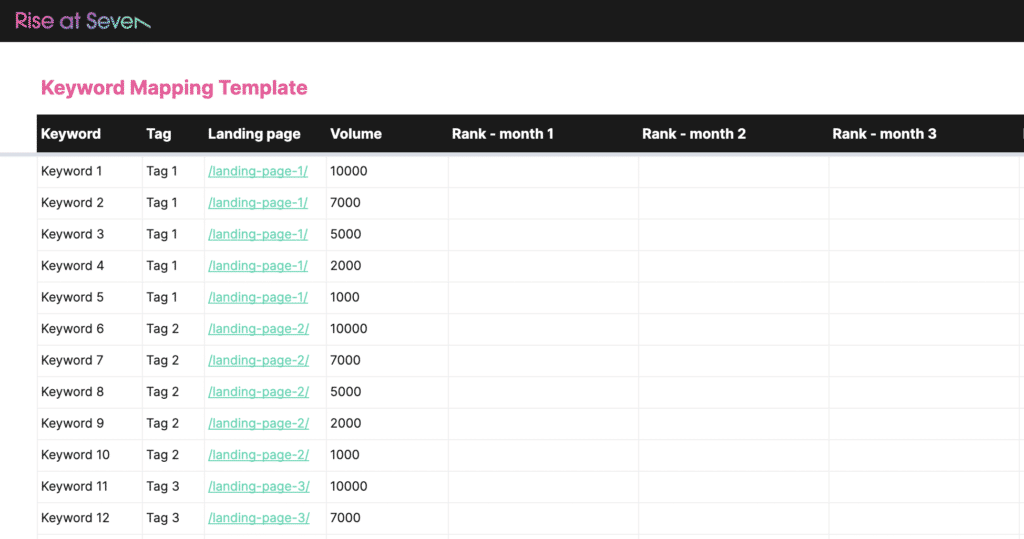
The beginner’s guide to keyword mapping (with template)

When you’re working in house, you often find yourself trapped in a loop of urgent work, with little to no time to evaluate your strategy and set out objectives for your site.
I’ve found myself in this position all too often. Going through the motions of business as usual without getting a good sense of the value of my work or being strategic about it.
In this article you’ll learn how to build a case to give yourself some strategy time by showing the long term value of it, and how to maximise the benefits of keyword mapping in your SEO strategy.
What is keyword mapping and why does it matter?
Keyword mapping is the process of pairing your target keywords to their goal landing pages.
The main benefits of keyword mapping are:
- An informed internal linking strategy
- Easily measuring the effectiveness of your SEO efforts
- More persuasive reporting
- Being able to notice and react quickly when things aren’t going well
So what are we looking to achieve? Ranking with the right pages for the right keywords at the bottom of the funnel.
A step-by-step guide to keyword mapping
Now that we know why we want to do this exercise and what we’re looking to achieve, let’s look at the “how”.
Use this guide as an orientation. Depending on the maturity of your site and your SEO efforts on it so far, some steps might not make sense to you.
You know your site best, so be confident in the choices you’re making and tailor this guide to your needs.
Step 1: Find your top pages
For this step, we’re going to use organic performance metrics from Google Analytics, but if your site is small or new, you’ll want to use your PPC data or, quite simply, your best judgement.
- On Google Analytics, access Behaviour -> Site content -> Landing pages. Use a date range that makes sense to you. I typically opt for 12 months to remove seasonality effects.
- Apply an audience segment for organic traffic. If you’re targeting some specific countries, edit the audience segment to include only your target countries.
- Choose your main goal, the one you use for reporting, and export the report. If you want to use more than one goal, you’ll have to export it more than once and unify them into a single report.
- We want to arrange the document to see Page, Sessions, Conversions and Conversion Rate.
- Remove all the URLs that aren’t “money pages”, such as testimonials, blog posts that don’t bring conversions, T&Cs… And use your knowledge of your company to remove any pages that are not key to the business and you’re not particularly concerned about ranking.
You have all the information you need to choose what your key landing pages are. Use this report to pick a selection of your 20 most important pages. Again, make this number make sense for you. Maybe you’re only aiming to rank for five pages at this moment.
Step 2: Find your seed keyword
Finding the main keyword you want to rank for with each page should be very intuitive as it is very likely to be in the URL.
In case you’re hesitating between keywords, you can inform your decision by checking a few sources:
- Consult Google Search Console to find your top performing queries for your top performing pages.
- Use your preferred keyword research tool to compare volume, difficulty and intent.
- Use PPC data.
You’ll want to find a nice balance between volume, difficulty and conversions.
Step 3: Expand your seed keyword
What I’m proposing here is a quick approach to keyword research. This will allow us to map, target and track the keywords that bring the most value to the business. We’re looking to optimise for the bottom of the funnel.
Some of the sources of information you can use here are:
- Your search terms report on Google Ads.
- The keywords these pages are ranking for as shown on Google Search Console.
- The keyword research tools on Ahrefs and SEMrush. You can use the sections for “having the same terms” and “phrase match”.
Next we’ll want to narrow down your findings to around 10 keywords and keyword variations per page. Assess this using volume, keyword difficulty and your market knowledge.
Look at the SERPs for these keywords and ask yourself the following questions:
- What user intent is Google assuming?
- Are my competitors ranking for these keywords too?
- Is it an ad heavy page? If so, it must have high commercial value.
Step 4: Build your keyword map
What your keyword map is going to look like is really up to you. If you’re only getting started, you can use my keyword mapping template.

Now it’s time to replicate this set up on your preferred rank tracker. Use your main keyword for each group as a tag for the group.
Tagging your keywords effectively will allow you to view very easily what keyword groups are growing, dropping and which ones have more than one landing page ranking for them, which could indicate that there are some cannibalisation issues in your site.
If you don’t know where to start, some of my favourite rank trackers are SEMrush, Ahrefs and SEOmonitor.
Step 5: Create an on-page optimisation roadmap
There are different issues or opportunities you might have encountered during this exercise. Each will be unique to your site, but here are some of the most common ones we’ve found:
- Missing content. During this exercise, you might have found that you were missing a page for one of your main keywords. The solution would be to create a page.
- Content that isn’t ranking. This might be due to a variety of issues and will have several different fixes. Some of the actions you can take are the following: Make sure there are no technical issues preventing the page from ranking such as inclusion on the robots.txt file, a rogue noindex tag, bad HTTP responses or poor page experience.Review the content to make sure it’s actually relevant.Find internal linking opportunities on your content, footer or menu.Check what your competitors are doing (and do it better).
- Make sure there are no technical issues preventing the page from ranking such as inclusion on the robots.txt file, a rogue noindex tag, bad HTTP responses or poor page experience.
- Review the content to make sure it’s actually relevant.
- Find internal linking opportunities on your content, footer or menu.
- Check what your competitors are doing (and do it better).
- Several pages targeting the same query. One solution would be to merge them into one page that serves the user best. Alternatively, you can choose to edit the content of one of the pages to cater to a more long tail version of that query.
I hope this guide has been helpful and you’ve found valuable optimisation opportunities, as well as a better way to report on the value of your work.
If you want to learn more about keyword volumes and optimisation on other channels like TikTok, read our TikTok SEO guide here
For a good guide on internal linking strategy, see this guide by Craig Campbell
















